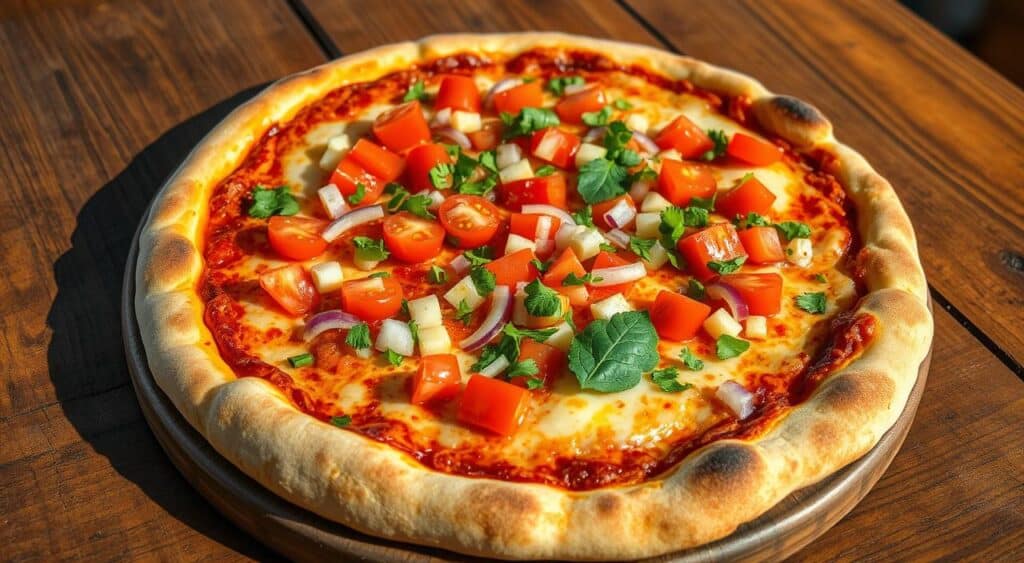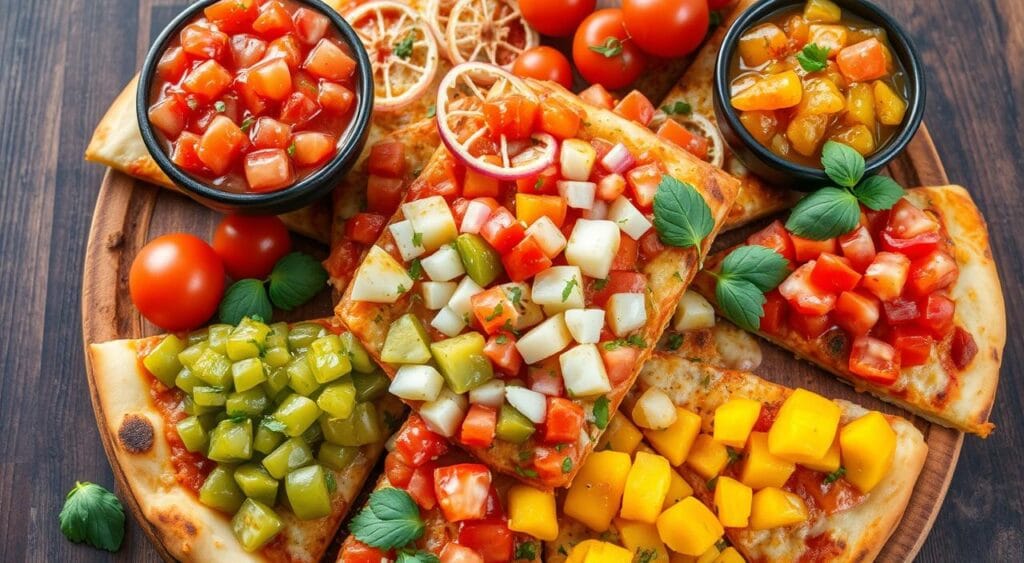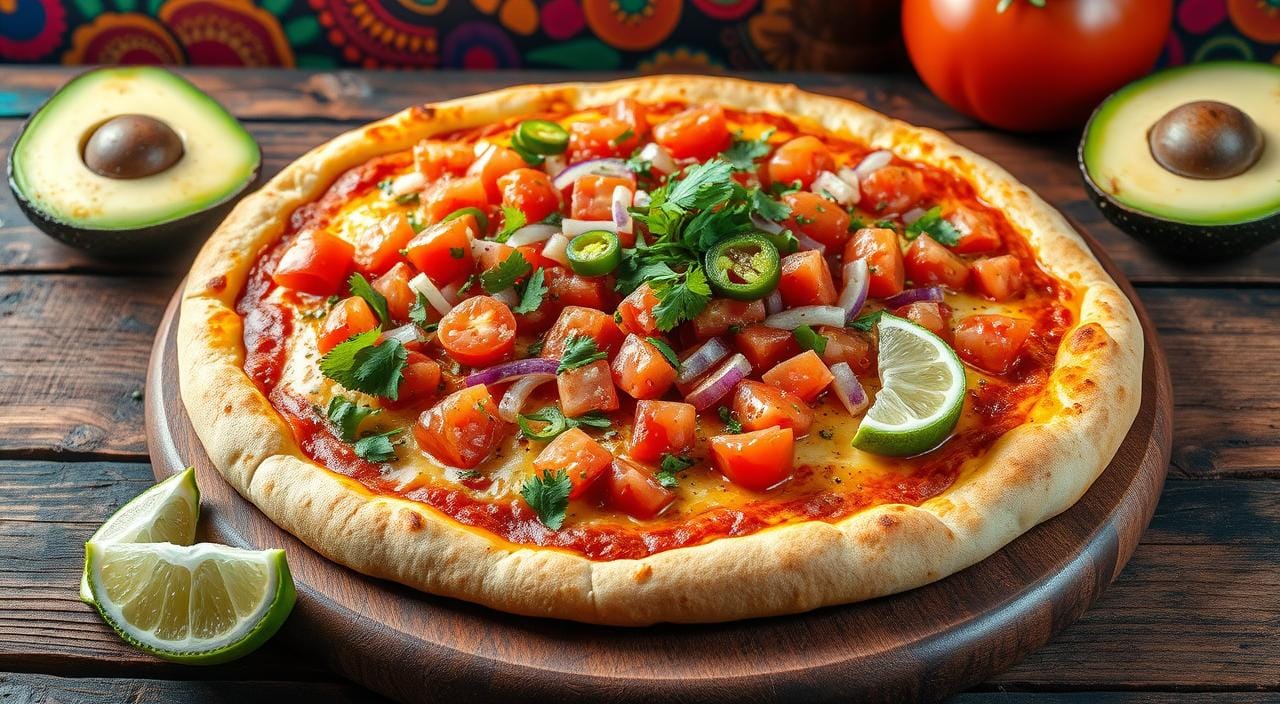Jump to:
Estimated reading time: 9 minutes
Table of contents
Many people stick to tomato-based pizza sauce, but there’s more to explore. Salsa on pizza is becoming a hit. It brings together Mexican and Italian flavors, making pizza night exciting.
Taco pizza is a great example of salsa’s role in pizza. It mixes refried beans, salsa, seasoned beef, and cheese. This mix gives a tasty twist to the classic pizza.
Key Takeaways
- It can be used as an alternative to traditional pizza sauce, adding a Mexican twist to your pizza
- Taco pizza, featuring a sauce and bean base, is a popular fusion dish that combines the flavors of tacos and pizza
- Salsa-based pizzas can be customized with various taco-inspired toppings like lettuce, tomatoes, green onions, olives, and sour cream
- Experimenting with different types of sauce, from mild to spicy, can create unique flavor profiles for your pizza
- It is a great option for spicy food lovers, offering a tasty and unconventional way to enjoy pizza night
Introduction
Making a delicious pizza is like creating art. It goes beyond just following recipes. We’re going to explore using salsa as an alternative sauce. This bold move can make your pizzas more exciting, whether you love spicy flavors or just want to try something new.
We’ll talk about why salsa is great for pizza, how to pick the right one, and how to make a perfect one. You’ll learn how to make your homemade pizzas even better, with more flavor and fun.
Why You Should Consider Putting Salsa on Pizza
It can be a delightful and unconventional alternative to traditional pizza sauce. It adds a bold, flavorful twist to your pizza. This comes from vibrant Mexican flavors like spices, tomatoes, onions, and peppers.
Salsa-based pizzas offer a unique fusion of Italian and Mexican cuisines. This creates a tasty and exciting dining experience.
A Flavorful Alternative to Traditional Pizza Sauce
Using it as the base can elevate your pizza with its bright, zesty flavors. The combination of diced tomatoes, onions, chili peppers, and aromatic spices in salsa provides a complex and tantalizing taste profile. This complements the other pizza toppings.
Adds a Mexican Twist to Your Pizza
Swapping out the traditional pizza sauce for salsa instantly transforms it into a Mexican-inspired masterpiece. The bold, spicy, and flavorful elements of it give your pizza a unique and exciting twist. This allows you to explore new culinary frontiers right in your own kitchen.
Perfect for Spicy Food Lovers
For those who crave a little extra heat, using it as the pizza sauce is a game-changer. Depending on the type of salsa you choose, from mild to fiery, you can customize the spice level to your personal preference. This makes salsa-topped pizzas a fantastic option for spicy pizzas that will satisfy your cravings.

Choosing the Right Salsa for Your Pizza
Choosing the right salsa is key. It should match the other toppings and your taste. Salsa comes in many heat levels, from mild to spicy. Pick one that fits your pizza best.
Types of Salsa: Mild, Medium, and Spicy
For a subtle Mexican twist, try a mild salsa. It lets other toppings stand out. If you like more heat, medium or spicy salsas add a nice kick. Try different salsas to find your perfect spice level.
Chunky vs. Smooth Salsa: Which Works Best?
Chunky salsas are better on pizza than smooth ones. They add texture and prevent crust sogginess. The chunky bits also make your pizza look and feel better.
Homemade vs. Store-Bought Salsa
Homemade salsa is fresh and vibrant. But store-bought salsas are convenient. Many store-bought salsas have unique flavors like pineapple or mango. Choose based on taste, availability, and flavor customization.
| Salsa Characteristic | Homemade Salsa | Store-Bought Salsa |
|---|---|---|
| Flavor Customization | High | Moderate |
| Freshness | Fresher | Varies |
| Convenience | Lower | Higher |
| Cost | Varies | Generally Lower |

Think about salsa types, consistency, and homemade vs. store-bought. This helps you pick the perfect salsa. It makes your pizza unique and delicious.
How to Make a Delicious Salsa Pizza Step-by-Step
Making a tasty salsa-pizza at home is simple. Begin with a good pizza dough. You can buy one or make your own pizza dough. Then, make the flavorful salsa base.
Spreading the Salsa Base
Use your favorite salsa as the base instead of tomato sauce. Choose from mild, medium, or spicy salsa. This depends on your taste and the toppings you’ll add.
Adding Toppings and Cheese
Spread the salsa base evenly. Then, add your favorite toppings. Options include seasoned ground beef, diced chicken, sautéed veggies, black beans, jalapeños, and shredded cheese. The cheese melts and holds everything together.
Bake the pizza until the crust is crispy and the cheese is golden. Serve it hot for a mix of spicy, savory, and cheesy flavors.
| Ingredient | Quantity |
|---|---|
| Pizza Dough | 1 batch |
| Salsa | 1 cup |
| Shredded Cheese | 2 cups |
| Seasoned Ground Beef | 1 pound |
| Black Beans | 1 (15-ounce) can, drained and rinsed |
| Jalapeños (sliced) | 1/4 cup |
Making a salsa pizza at home is a fun twist for pizza night. Start with good pizza dough, add savory salsa, and top with your favorites. It’s a meal that spicy food lovers will love.
Topping Ideas for a Salsa-Based Pizza
Creating a salsa lets you get creative with toppings. You can mix traditional pizza toppings with Mexican flavors. This mix of tastes can make your pizza stand out, pleasing many palates.
Traditional Pizza Toppings that Pair Well with Salsa
For a taste you know, try pepperoni, mushrooms, and bell peppers. These toppings add texture and balance out the salsa’s boldness. They make the pizza feel complete.
Mexican-Inspired Toppings: Jalapeños, Black Beans, and More
For a Mexican twist, add jalapeños, black beans, corn, and cilantro. These ingredients bring a spicy kick and a fresh taste. They’re great for those who love spicy food.
Cheese Options for a Perfectly Melty Pizza
Choosing the right cheese is key for a tasty salsa. Go for cheddar, Monterey Jack, or a Mexican blend. These cheeses melt well, adding a creamy touch that matches the salsa’s boldness.
Playing with toppings, from classic to Mexican, makes a unique salsa. Whether you like pepperoni or jalapeños, salsa offers endless possibilities.
Variations of Salsa Pizza to Try
Once you’ve mastered the basic salsa pizza, the possibilities are endless. Try different toppings and flavors to make your pizza nights exciting. Here are three delightful variations to consider:
Vegetarian Salsa Pizza with Fresh Veggies
For a meat-free option, top your pizza with fresh veggies. Use crisp bell peppers, sautéed mushrooms, zesty onions, and more. The salsa adds a tangy, spicy touch that goes well with the veggies. Add a generous sprinkle of melty cheese for a satisfying vegetarian salsa pizza experience.
BBQ Chicken Salsa Pizza
Want a savory twist on the classic salsa pizza? Try a BBQ chicken salsa pizza. Start with BBQ sauce, then add shredded rotisserie or grilled chicken, your favorite salsa, and cheese. The smoky, sweet, and spicy flavors mix perfectly, making every bite full of flavor.
Breakfast Salsa Pizza with Eggs and Bacon
For a breakfast-inspired salsa pizza, use scrambled eggs, and lots of salsa. The earthy, savory flavors of breakfast go well with the zesty salsa. This breakfast salsa pizza is a great way to start your day.
Try these and other innovative salsa pizza toppings to find your new favorite. Whether you like vegetarian, BBQ-inspired, or breakfast-themed pizzas, there’s a salsa-based option for every craving.
Common Mistakes to Avoid When Using Salsa on Pizza
It can add a tasty twist to your pizza, giving it a Mexican flavor. But, there are a few mistakes to avoid when using it on your pizza.
Overloading the Pizza with Salsa
Using too much salsa is a big mistake. Too much can make the crust soggy and overpower the taste. Use just enough to coat the dough and enhance the toppings.
Choosing the Wrong Salsa Consistency
The salsa’s consistency is key. Chunky salsa works better than smooth because it doesn’t soak the crust. Smooth salsa can make the pizza soggy and hard to slice.
Not Draining Excess Liquid
Not draining the salsa’s liquid is another mistake. Salsa has a lot of moisture that can make the crust soggy. Make sure to drain it well before spreading it on the dough for a crispy crust.
By avoiding these mistakes, you can make a delicious salsa pizza. It will show off the unique flavors of salsa.
Frequently Asked Questions
Can you use salsa as a pizza sauce?
Yes, salsa can be used as a pizza sauce for a flavorful twist! It works well with toppings like cheese, peppers, onions, and meats, giving the pizza a zesty, Southwestern-inspired taste.
What toppings go well with salsa on pizza?
Toppings that pair well with salsa on pizza include shredded cheese (like Monterey Jack or cheddar), grilled chicken, bell peppers, onions, jalapeños, and black beans. These toppings complement salsa’s flavors and create a unique pizza.
Will salsa make the pizza crust soggy?
Salsa can make the crust a bit more moist, so it’s best to use a thick salsa or drain some of the liquid before spreading it on the pizza. Baking at a high temperature also helps achieve a crispy crust.
Can I use salsa on homemade or frozen pizza?
Yes, you can add salsa to both homemade and frozen pizzas. Simply spread a thin layer on the crust before adding your other toppings and baking as usual.
Conclusion
It can make your pizza taste amazing, blending Italian and Mexican flavors. By picking the right salsa, preparing it well, and trying different toppings, you can make a pizza that’s both tasty and memorable. It’s a great way to spice up your pizza nights or impress friends with a unique dish.
From a barbecue chicken salsa pizza with bold flavors to a veggie pizza with fresh salsa, the options are endless. Why not try salsa pizza and find a new favorite? It’s a fun way to mix up your pizza game.
Adding it to your pizza can make it exciting, whether you’re a pizza expert or just starting out. Next time you make pizza, think about using salsa instead of traditional sauce. Your taste buds will love it!






